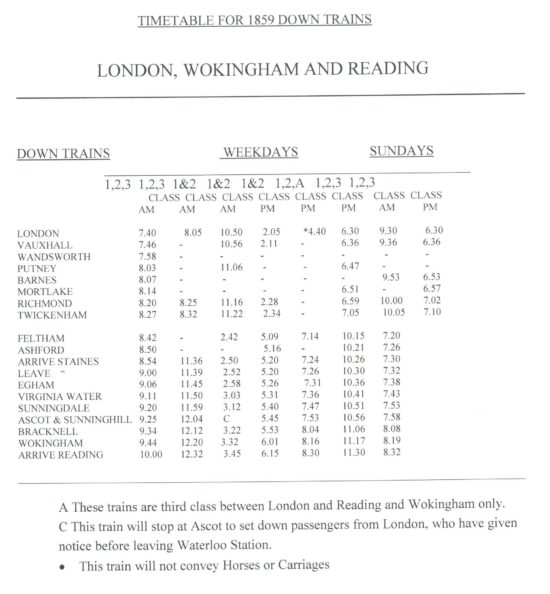The Railway comes to Egham
Planning & Opening

Plans for a railway line to connect Egham with Waterloo were first proposed as early as 1846. In 1852, the Staines, Wokingham & Woking Junction Railway was proposed and the following year, the Railway Bill was passed; Church bells were rung across Egham in celebration.
There were, however, objections. These were in relation to the fact that the line would cross 12 roads. Further difficulty came when many land owners refused to sell their property until suitable compensation was agreed. Further upset came when two workers died in 1855: a boy named Fields who was run over by a truck, and a man called Tripp who fell and was also run over by a cart.
Despite this, the line officially opened on 4th June 1856. The line was operated by an independent company called ‘London & South Wester Railway’ (LSWR) and Mr Rutter from Kingston was Egham’s first Station Master. The line was an extension of the already existing Waterloo to Windor via Staines line that opened in 1948 and continued to Egham, Trostsworth (later renamed Virginia Water), Longcross, Sunningdale and finally, Ascot.

Trains, Tickets and Developments
The timetable as detailed in 1859 shows that six trains ran on weekdays and two on Sundays. The cost of a First Class single ticket from London to Egham was 3s 8d.
The line was soon extended to Reading with the link from Virginia Water to Chertsey, connecting the existing line to Weybridge, being completed in 1866. Electrification of the line took place in 1939, just before the outbreak of the Second World War.
Accidents
One of the earliest recorded accidents occurred on Tuesday 7th June 1864. There was a collision between two special passenger trains returning to London from Ascot. The trains were due to leave Ascot at five minute intervals, but the first train was delayed at Egham due to a passenger being thrown off the train for ‘card-sharpening’. The train had just left Egham at 7.28pm when it was run into by the following train. Five passengers were killed outright, one dead later due to his injuries. The dead were taken to the Railway Inn on Station Road.
The inquest was opened on 9th June at the Railway Inn. A jury having been sworn in proceeded to the Coach House of the Railway Inn where lay the remains of the unfortunate deceased. The bodies were in a dreadful condition and subsequently the inquest was moved to the Reading Room of the Literary Institute.
Another collision occurred on 1st October 1900 at Virginia Water between a train from Weybridge, leaving for its return journey, and a goods train from Staines. The line had long been considered dangerous as the approach to Virgina Water’s station is obscured by the bridge over the railway. Fortunately, the passenger train was empty other than the guard and engine driver. The drivers of both trains were badly hurt, and the carriage in which the guard was in, was crushed causing him to be severely injured. Three resident medical officers, Dr Tinker, Dr Harper and Dr Despard, were able to go to scene quickly due to the close proximity of Holloway Sanatorium and were attended to on the scene.

More recently, on 19th October 2000, a bus was dragged 100m after being hit by an empty train. The accident occurred when the bus with eight passengers and the driver, became stuck on the Pooley Green crossing when the barriers came down and blocked it in. All the occupants of the bus were able to evacuate before the train, which had been emptied of all passengers at Staines, slammed into the bus. The bus crashed through a house before being pushed another 50m where it landed in a garden of another house. Fortunately, no passengers or bystanders were injured in the collision.
Accommodation
The Railway Hotel, on Station Road, was built to accommodate travellers visiting Egham. Designed to ‘support a respectable trade’ the hotel was owned by Friary Holroyd of Guildford. On the other hand, the Prince of Wales, built in 1892 was described as a lodging house for a lower class of people. While the Railway Hotel building still remains, the Prince of Wales was demolished in 1972 to make way for the ring road (Church Road).

Society Changes
The railways changed society considerably. They were cheaper than horse and coach travel and a lot quicker, meaning travel across Britain was much easier. Even the poor could afford rail travel as three different classes of travel existed – third class meant travelling in open topped carriages. Towns and cities had cheaper food as farmers could get their perishable products to market quicker and cheaper.
Egham had its own siding railway line which ran from the goods yard to the corner of the High Street and Station Road. It was installed between 1870 and 1896 and was said to be horse-hauled. The loading bay was in School Lane and was used by Corn & Seed merchants Drake & Mount. Later, the bay was also used to unload cattle (which has been brought all the way from Hatherley in Devon). The cattle was then herded through the High Street to the slaughter house, which was behind Clarke’s the butcher (now Costa).


